There are few things I enjoy more while traveling than coming home with a suitcase full of regional candy. Why not? There’s something to be said for souvenirs you can stress eat after returning to daily life. And taste is one of the easiest ways to revisit memories. (Right after smell, which, BTW, candy also has. Win.) In the name of reclaiming some of that old vacation glow, I’ve binged on Christmas cookies from Spain, marzipan from Germany, and Polish dried plums. But there’s only one candy I associate with Japan: Kit Kats.
Even though Nestlé is Swiss and the Kit Kat was invented in the UK, it’s the Japanese that have taken the wafer and chocolate combo to the next level. Don Quijote (Japan’s answer to Target) seems to carry nearly every candy in the Land of the Rising Sun, plus it has multiple Kit Kat–devoted shelves. The brand even runs a string of Chocolatories in high-end department stores, where under a string of jeweler’s cases you can buy selects from the high-end line of “special” Kit Kats.
Quality control is high, and each bar is actually infused with the ingredients it claims on its label. But as I learned on a recent candy shopping spree in Tokyo, not every flavor translates. With the help of several locals and a few sugar-addled tourists, I bravely plowed through as many different variations as possible. From the truly divine to the, “wait—huh?,” here’s FLOOD’s ultimate Japanese Kit Kat power rankings. From best to worst.
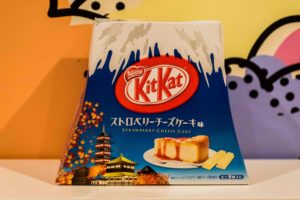 Strawberry Cheesecake
Strawberry Cheesecake
Different areas of Japan sell different Kit Kats, meant to celebrate their local snacks and preferences. It isn’t totally clear what strawberry cheesecake and Mount Fuji have in common—but regardless, I’d vote this special edition, sold in a mountain-shaped box, as my favorite—particularly upon discovering that the Kit Kat wafer plays the role of a graham cracker crust. Accidental inventiveness, or was my sugar-addled brain reaching? Why not both?
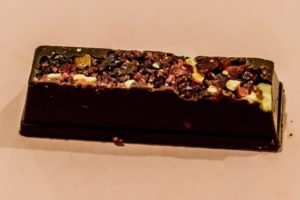 Cranberry Almond
Cranberry Almond
Cranberry almond Kit Kats are packaged in single bars, instead of Kit Kat’s traditional two-bar configuration, making it a modest grab-and-go dessert. It also feels more upscale than most entries on the list, thanks to dark chocolate, the sour hint of cranberries, and a dusting of actual almonds. Classy.
 Matcha
Matcha
This is the non-chocolate flavor most exported—with good reason. Given Japan’s talent for infusing green tea into everything from cake, to ice cream, to high end restaurant treats, they naturally excel at Matcha Kit Kats. A bit grainy, a lot earthy, and a much-needed fun twist on their dessert traditions.
Black Tea
You know those annoying people who take one bite of cake and say something like, “Oh it’s so sweet I just couldn’t finish it!” Yeah—I’m not one of those people. However, there’s something very appealing about a candy that, from sniff to crunch, embodies a perfect cup of milky English breakfast tea with only a hint of sugar. Someone I was with called it “breakfast candy.” And while I can’t fully advocate for the idea, I’m not not telling you to give it a go.
Pistachio & Raspberry
Purchased at a Kit Kat retailer in the heart of Tokyo, Pistachio & Raspberry is easily one of the best specialty flavors: a subtle pistachio paired with a thick, almost jam-like raspberry. Even though a member of my committee confessed he doesn’t like tea (the horror!), even he says he’d down a cup as an accompaniment to this perfect, cake-like candy. So apparently it also inspires minor miracles. (Cannot promise this effect is universal.)
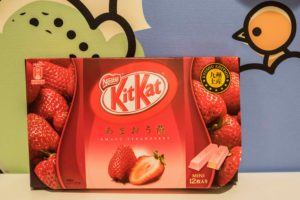 Strawberry
Strawberry
A super-sweet, millennial-pink, adult-approved, Strawberry Quik–like treat. Tastes like it was almost scientifically designed to hit pleasure centers with minimal complexity and maximum payoff. Don’t think too hard about this one.
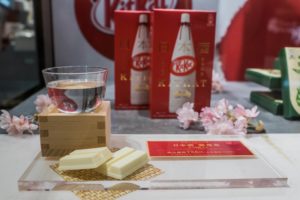 Sake
Sake
The only flavor to be met with universal “oh wows” from my informal committee of tasters. From the red wrappers (generally considered to be good luck in Japan) to the pure white bar with a crunch that feels almost bubbly, this is the candy equivalent of throwing back a glass of rice wine in Tokyo’s Golden Gai neighborhood. It’s a comparison only heightened by the Kit Kat’s alcoholic essence. And even though you won’t get drunk on it, the flavor definitely went straight to my head.
Matcha and Kinako
Another tribute to Japan’s most powerful tea, accompanied by kinako (roasted soybean flour). After several back-to-back taste tests with the straight-up matcha flavor, the most we could determine is that it tasted slightly earthier and maybe a bit grittier. Not angry by any stretch of the imagination, but a case of less being a tiny bit more.
 Sublime
Sublime
How upscale do you want your Kit Kat? Sublime, actually made out of super dark chocolate, is the ultimate mass-produced candy flex. It smells like pure chocolate and tastes so intense no one could eat more than a bit of it. Loved its ambition, hated that it made me the kind of one-bite dessert person I’ve always made fun of.
Strawberry Maple
Strawberry and maple might not be the most obvious flavor pairing, but this breakfast collision works because, as we established earlier, Kit Kat has essentially cornered the market on strawberry-flavored candy. The maple is secondary here, mainly present as an earthy, seemingly sticky aftertaste. Too full of nostalgia for complaints.
Butter
My jury was ultimately mixed on this flavor, but bite and listen closely. If you hear Julia Child calling for “More butter!,” know that you’re not alone.
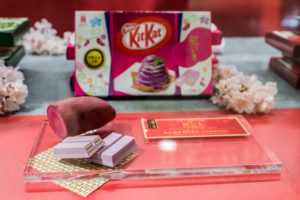 Taro
Taro
Taro is a tropical root. Used in Japanese desserts like pudding, ice cream, and cake, it’s a subtle flavor, like a sweet potato. Used in a Kit Kat, it results in a slightly confusing blend of starches with no clear winner. At least the bar is a pretty shade of lavender.
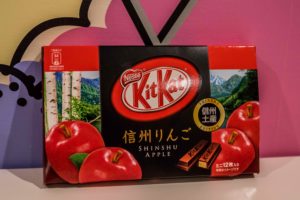 Apple
Apple
One of the few special flavors not dyed in test-tube hues, that’s the only natural thing about Apple Kit Kats. Like essence of Jolly Rancher shoved into a chocolate coating, this is more like edible perfume than candy. Then there was the aftertaste, which only faded after several frantic gulps of water. Like Eve in the Garden of Eden, I found myself regretting having taken a bite.
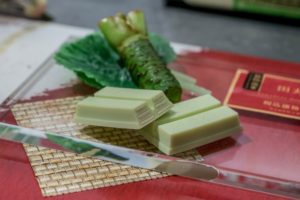 Wasabi
Wasabi
This was the flavor my committee was most scared of, because who eats straight-up wasabi? But I was pleasantly surprised by this flavor straight from Bertie Bott’s playbook. While the essence of wasabi spice is very present, when mixed with the white chocolate, there’s no fire. Combined with the crunchy bar center, it tasted a bit like a candied version of wasabi peas. However, it was unanimously ranked low on everyone’s list due to its novelty factor, which reduces it to more cool party trick than everyday candy selection.
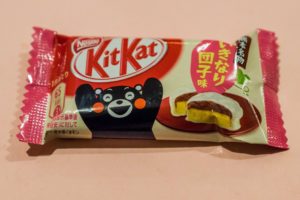 Red Bean and Mochi
Red Bean and Mochi
Red bean and mochi is a popular dessert combination in Japan, the mochi’s sugary fluffiness giving the red bean’s earthiness a much-needed hit of sweet. But if traditional Japanese dessert flavor’s sophisticated notes are calligraphy, Kit Kat’s take is closer to me attempting to scribble my name on a supermarket checkout pad. The overwhelming taste here is cheap white chocolate, but it does get bonus points for the cute bear on the wrapper—even though when I look closely, I can see a sense of betrayal in his eyes.
 Diamond
Diamond
According to Japanese tradition, carrying your birthstone provides you with special protection. Given that, I decided to get in the game at the Kit Kat Chocolatory, and purchased April’s birthstone special: Diamond. (Because who doesn’t need more protection during tax season?) It tasted like nothing. In theory, I was snacking on rum raisin, but I would have never known if not for the online promotional material. A tribute to the power of marketing and little else. FL







